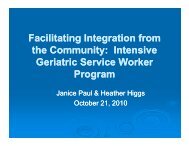
Community Care Common Standards Guide - Department of Health .
Community Care Common Standards Guide - Department of Health .
YUMPU automatically turns print PDFs into web optimized ePapers that Google loves.


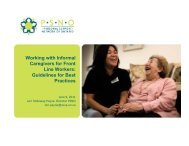
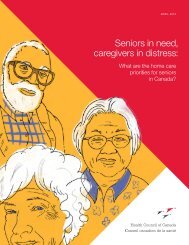
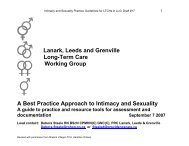
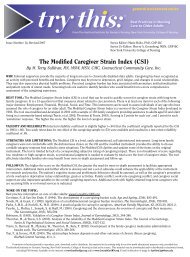
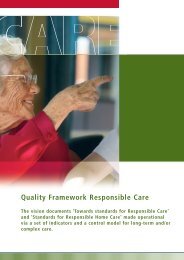
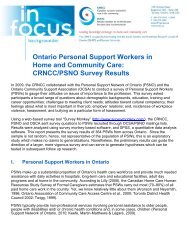
THE COMMUNITY CARE COMMON STANDARDS SECTION 33. THE COMMUNITY CARE COMMON STANDARDSThis section sets out the three Standards, including the overarching principle for each standard,the 18 expected outcomes relating to the Standards, and practices and processes that supportthe achievement of the expected outcomes.3.1 STRUCTURE OF THE COMMUNITY CARE COMMON STANDARDSThe Standards are made up of three Standards and 18 expected outcomes relating to those Standards.Each of the Standards includes a principle that summarises the intent of that Standard.The three Standards are:1. Effective Management2. Appropriate Access and Service Delivery3. Service User Rights and Responsibilities.Each of the 18 expected outcomes relating to the Standards includes the following information:• A description of practices and processes that support the achievement of that expected outcome• Information on the type of evidence that the quality reviewers may look at while assessing thatexpected outcome• Some considerations to assist service providers in addressing the expected outcomes (whereapplicable).Section 5 contains additional information about addressing the Standards, including:• Some key program considerations for each of the community care programs related to some expectedoutcomes (service providers are encouraged to become familiar with specific program guidelines andfunding agreements, as this list is not exhaustive)• Other information that may be helpful in guiding service providers to meet the expected outcomes,such as references to other standards and resources.Note: The Standards are intended to guide a range of community care service provision. However, it isexpected that more detailed practices and processes will be in place for the delivery of more complex careand services.The three Standards, the principle for each Standard and the corresponding expected outcomes arepresented in Figure 3.1. The Standards, expected outcomes and practices and processes are then providedin full on the following pages.COMMUNITY CARE COMMON STANDARDS GUIDE Page | 20
THE COMMUNITY CARE COMMON STANDARDS SECTION 3Figure 3.1: The Community Care Common StandardsStandard 1: EffectiveManagementThe service providerdemonstrates effectivemanagement processes basedon a continuous improvementapproach to servicemanagement, planning anddelivery.Standard 2: AppropriateAccess and ServiceDeliveryEach service user (andprospective service user) hasaccess to services andservice users receiveappropriate services that areplanned, delivered andevaluated in partnership withthemselves and/or theirrepresentative.Standard 3: Service UserRights and ResponsibilitiesEach service user (and/ortheir representative) isprovided with information toassist them to make servicechoices and has the right(and responsibility) to beconsulted and respected.Service users (and/or theirrepresentative) have accessto complaints and advocacyinformation and processesand their privacy andconfidentiality and right toindependence is respected.Expected Outcome 1.1: Corporate GovernanceThe service provider has implemented corporate governance processes that areaccountable to stakeholders.Expected Outcome 1.2: Regulatory ComplianceThe service provider has systems in place to identify and ensure compliance withfunded program guidelines, relevant legislation, regulatory requirements andprofessional standards.Expected Outcome 1.3: Information Management SystemsThe service provider has effective information management systems in place.Expected Outcome 1.4: Community Understanding and EngagementThe service provider understands and engages with the community in which itoperates and reflects this in service planning and development.Expected Outcome 1.5: Continuous ImprovementThe service provider actively pursues and demonstrates continuous improvementin all aspects of service management and delivery.Expected Outcome 1.6: Risk ManagementThe service provider is actively working to identify and address potential risk, toensure the safety of service users, staff and the organisation.Expected Outcome 1.7: Human Resource ManagementThe service provider manages human resources to ensure that adequate numbersof appropriately skilled and trained staff/volunteers are available for the safedelivery of care and services to service users.Expected Outcome 1.8: Physical ResourcesThe service provider manages physical resources to ensure the safe delivery ofcare and services to service users and organisation personnel.Expected Outcome 2.1: Service AccessEach service user’s access to services is based on consultation with the serviceuser (and/or their representative), equity, consideration of available resourcesand program eligibility.Expected Outcome 2.2: AssessmentEach service user participates in an assessment appropriate to the complexity oftheir needs and with consideration of their cultural and linguistic diversity.Expected Outcome 2.3: Care Plan Development and DeliveryEach service user and/or their representative, participates in the development ofa care/service plan that is based on assessed needs and is provided with the careand/or services described in their plan.Expected Outcome 2.4: Service User ReassessmentEach service user’s needs are monitored and regularly reassessed taking intoaccount any relevant program guidelines and in accordance with the complexityof the service user's needs. Each service users’ care/service plans are reviewed inconsultation with them.Expected Outcome 2.5: Service User ReferralThe service provider refers service users (and/or their representative) to otherproviders as appropriate.Expected Outcome 3.1: Information ProvisionEach service user, or prospective service user, is provided with information(initially and on an ongoing basis) in a format appropriate to their needs to assistthem to make service choices and gain an understanding of the services availableto them and their rights and responsibilities.Expected Outcome 3.2: Privacy and ConfidentialityEach service user’s right to privacy, dignity and confidentiality is respectedincluding in the collection, use and disclosure of personal information.Expected Outcome 3.3: Complaints and Service User FeedbackComplaints and service user feedback are dealt with fairly, promptly,confidentially and without retribution.Expected Outcome 3.4: AdvocacyEach service user’s (and/or their representative’s) choice of advocate is respectedby the service provider and the service provider will, if required, assist the serviceuser (and/or their representative) to access an advocate.Expected Outcome 3.5: IndependenceThe independence of service users is supported, fostered and encouraged.COMMUNITY CARE COMMON STANDARDS GUIDE Page | 21